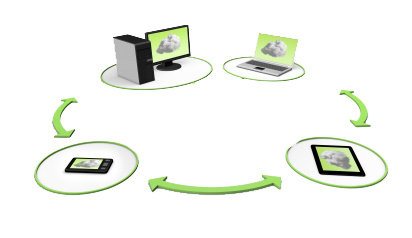In 2012, “mobile” doesn’t just mean logging on via a smartphone or tablet. The “mobile” customer is jumping from smartphone to laptop to tablet, at the office, in the car, on the sofa, and in the store. Today’s customers just won’t sit still, and their attention span is getting shorter and shorter.
Mobile websites are becoming increasingly important but there’s a lot more to it than just making sure a website looks good and loads on a smartphone. There isn’t one stream of visitors shopping the desktop site, and another stream shopping the smartphone site, and another shopping the tablet site. They’re bouncing from one to another depending on where they are and what they want to do, and they expect a site to be similarly satisfying no matter how they’re viewing it. This means that if you lose a shopper on a smartphone or tablet, you may lose them on the desktop too, and you might lose them for good.
Chasing down the multi-tasking, multi-device shopper requires a commitment to delivering outstanding experiences – and insisting on outstanding performance – on all three screens.
Online habits are not all the same
The online retailing process would seem pretty straightforward: have the right products at the right price, a smooth checkout process, good overall site performance and count the sales rolling in. Those are all a given, but this is just part of the story of what consumers are really doing when they go online to shop.
According to Forrester Research, a fifth of shoppers do product research on Google and just under this visit Amazon for product information. Ultimately, the majority make a purchase in a brick-and-mortar store, and for those that do buy online, most use their computer.
On the mobile side, shoppers use smartphones tactfully – to find stores, research products, prices, as well as looking up online reviews. Once they gather their information, over a third of shoppers purchase the product at the store they’re in, whereas a fifth make the purchase online. For tablets, shoppers prefer to use these for doing research and reading reviews. When it comes to actually making a purchase, the tablet is preferred by a wide margin – 42 percent to 29 percent – likely because of a combination of the larger form factor and perhaps a greater feeling of security.
This data tells us that an effective retail strategy needs to be everywhere, all the time with an experience that’s going to make a consumer pause on their here-there-everywhere shopping journey. The mobile site has to provide quick and easy access to locations, pricing, and some product details. The tablet site has to be rich with product details and reviews. The full site has to give them everything. And of course, the checkout process must be smooth and effortless, including touch-friendly controls as needed.
There’s no “one site fits all,” and each channel needs to address the needs and tasks of the user and the device they happen to be on at the time. Given that smartphone share and tablet share keep getting bigger and bigger, a “three-screen” strategy is the only way a retailer can be confident that they are maximising revenue. Performance management is an essential pillar of that strategy.
Performance counts
Website performance – whether that is on mobile, tablet or desktops – needs to be a high priority, and monitoring needs to be engrained into the company culture 365 days a year. It not only improves customer experience but increases conversion rates as customers come to trust that the website will deliver.
In addition to ongoing performance management, it’s vital for retailers to stress-test desktop and mobile sites in anticipation of busy periods – such as Christmas. A crush of visitors can bring even a normally well-performing site to its knees and take a significant chunk of revenue with it.
Mobile, or more specifically over-the-air wireless, presents formidable performance challenges, many of which are inherent in the network itself. The main culprit is latency; that dreaded pause as the signal is relayed back and forth between the mobile device and the cellular network. Mobile magnifies the latency issue, and on a device that is built for convenience, this is far from ideal.
An early Christmas present
Creating a uniformly delightful, consistently successful experience across myriad devices is no easy task. It takes an understanding of user goals for each class of device, and a commitment to making sure site performance is exceptional across the board. Retailers that vet the performance of their desktop sites and make the investment in creating high-performance mobile experiences can anticipate better results generally and throughout busy periods.






